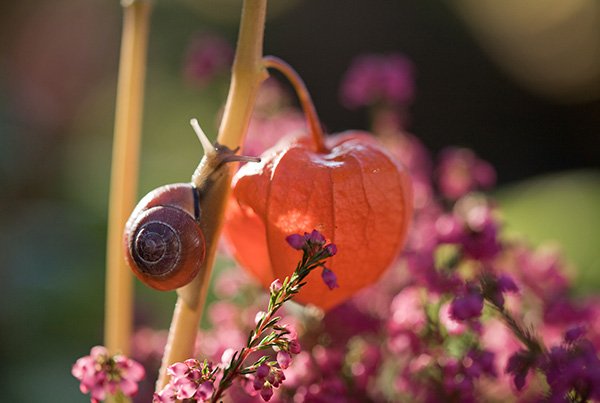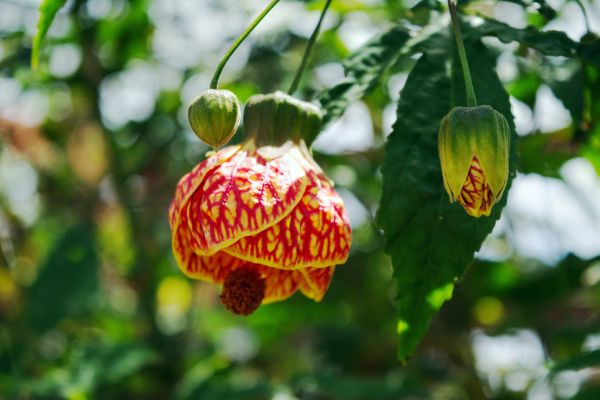The Chinese lantern plant is a beautiful addition to any garden; it can be grown in the ground or in a container. The perennial plant provides beautiful bright green growth and small flowers in the summer. But the real appeal is the bright orange, bell-shaped husks on the seed pod! In dried flower arrangements, these papery pods retain their vivid color.
To help you grow this beautiful plant successfully in your garden, below, we'll go through everything you need to know to grow your own Chinese lantern plant and enjoy that burst of color.
Botanical Name
Common Name
Plant Type
Mature Size
Sun Requirement
Soil Type
Hardiness Zone
Pet Friendly
Physalis alkekengi
Chinese Lantern Plant
Perennial
1 to 2 feet tall and wide
Full sun to partial shade
Well-draining, loamy
3-9 USDA
No
What Is The Chinese Lantern Plant?
The Chinese lantern plant (Physalis alkekengi) is also called bladder cherry, Japanese lantern, or winter cherry. They are ornamental, perennial plants that are actually members of the nightshade family, just like eggplants and tomatoes!
You can see the resemblance when you look at the seed pods. The bright orange seed pods of the Chinese lantern plant look like paper lanterns (hence the name) and are similar to the papery husks of tomatillos and husk tomatoes. They are also sometimes called winter cherry, bladder cherry, or strawberry ground cherry.

Image source: Unsplash
Chinese Lantern Plant Care Requirements
Light
The Chinese lantern plant needs plenty of full suns, like all nightshades. It can tolerate some shade - and indeed, some shade may be necessary if your afternoon sunlight is particularly strong. However, it does best in west or south-facing locations.
Water
During the first year's growth, water your Chinese lantern plant frequently until its roots get established. In subsequent years, you won't need to water as frequently. Chinese lantern plants can succumb to root rot. Part of the reason is that this plant shows the same signs for underwatering and overwatering - yellow, wilted leaves. It's important to always check the soil moisture before going to water your plant.
Temperature
The Chinese lantern plant is native to southern Europe and northern Asia, and this equates to USDA growing zones three through nine in the United States.
Chinese lantern plants require nighttime temperatures to stay at or above 55 degrees Fahrenheit in order to keep growing. When a frost hits, the plant will go dormant. If you'd like your Chinese lantern plant to keep a year-long growing season, you can bring it indoors in the fall - just be sure to debug it first!
Young plants are vulnerable to cooler temperatures, and it's only when they become fully established in the garden that they are more resilient.
Soil
It's best to grow Chinese lantern plants in containers and keep the soil moist- they are an invasive plant and produce an abundance of underground runners otherwise.
If grown in a pot, use well-draining soil. Nearly any potting soil will do, as most contain perlite that will help prevent the soil from retaining too much moisture. If grown in-ground as a garden plant, consider mulching around the base with hay or straw, which helps keep the soil evenly moist while keeping the weeds down.
Fertilization
It's really not necessary to fertilize Chinese lantern plants. If you'd prefer, you can apply a balanced fertilizer once a month during the spring and summer.
Propagating Chinese Lantern Plants
Propagating Chinese lanterns is best done by sowing them from seeds. Chinese lantern plant seeds are readily retrieved from those orange husks!
Plant Chinese lantern seeds indoors in trays filled with well-drained soil about eight weeks before your zone's last frost date.
Keep the tray of seeds in a warm, sunny place, and keep the soil surface evenly moist. You should see germination after about three weeks!
Transplant the young seedlings to a pot or garden location of your choice once the danger of frost has passed.
If you don't want to deal with indoor seedling trays, you can absolutely sow the seeds outdoors in the spring, and you will just have a shorter growing season the first year.

Image source: Unsplash
Harvesting Chinese Lantern Plants
The main garden merit for Chinese lantern plants is the colorful seed pods the plant produces! In the middle of summer, the plant blooms with small white flowers, which then grow into tiny berries surrounded by a ballooned husk. That husk is called a calyx, turning from green and yellow to a deep, reddish-orange. It's the perfect color for fall, and most gardeners grow Chinese lanterns specifically for those autumnal seed pods!
To harvest stalks of seed pods, cut each stem at the base in the early fall, when the orange husks are still bright and haven't started to turn brown. Strip off the leaves, then hang the stem upside down in a dark, cool place. A closet, garage, or basement is a good option for this! Be sure the location has good air circulation. After a few weeks, the pods should be dry and ready for you to use in decorating!
Common Problems With Chinese Lantern Plants
The Chinese lantern plant is a hardy perennial, but it does battle a decent amount of insect pests. Flea beetles, cucumber beetles, and false potato beetles might appear. Treat your Chinese lanterns with insecticidal soap or neem oil if you spot them.
Chinese lantern plants also sometimes struggle with diseases caused by overwatering. Root rot is a fungus that stems from the soil being too wet for too long. Black rot is a bacterial disease that appears in overly humid conditions, and it attacks the leaves, causing them to turn yellow and fall off. Be sure not to overwater, and make sure your plant has ample airflow around the plant.
Are Chinese Lantern Plants Pet Friendly?
No, Chinese lantern plants are highly toxic to both pets and humans! All parts of the plant contain solanine, which is poisonous in small amounts and fatal in large doses. Keep your children and pets well away! Chinese lantern plants are strictly ornamental!

